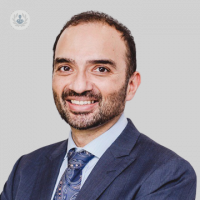Ski safe: Top tips to prevent ACL tears on the ski slopes
Written by:One of the most common ski injuries is a tear to the anterior cruciate ligament (ACL) in the knee, which is likely to cut short fun on the ski slopes. We asked leading consultant knee surgeon and limb reconstruction specialist Mr Amir Qureshi to share his top tips on preventing this type of injury while skiing.

ACL tears are one of the most common ski injuries. How do they happen?
An ACL is ruptured mainly when there is a twisting injury with a sideways force. When you’re skiing, one foot often gets planted, your body twists and your leg and your knee go sideways. That’s the perfect mechanism for you to rupture your anterior cruciate ligament, or ACL as it’s commonly called.
How are full ACL tears treated?
The treatment of ACL injuries really depends on the patient and whether there have been other injuries sustained in the knee together with the ACL. Before making a decision about treatment, I like to take a full history and also establish what the expectations of the patients.
Sometimes, if only the ACL is injured, a course of physiotherapy and strengthening the leg is enough to support a good recovery. However, in any case, it’s important to keep a watchful eye on the patient’s recovery and if, for example, they couldn’t go back to the sport that they love, we could intervene more urgently.
The other thing that’s important to consider is if the meniscus, the knee’s shock absorber, is also damaged together with the ACL. A torn meniscus can lead to earlier wear and tear on the knee and ideally, in both younger and older patients, I like to repair or remove the meniscus rather than let it degenerate away. The aim of repairing the meniscus is to stabilise the knee. In the case that the ACL has ruptured as well, I would likely advocate a reconstruction of the ACL at the same time as the meniscal repair. This would give the best chance of healing and would prevent the after effects of not having a complete meniscus over the coming years.
How can people avoid having an ACL tear in skiing?
To avoid getting an ACL injury in the first place there are a number of steps someone could take. First of all, prepare for your ski holiday. Just as you would prepare for a marathon, there are specific exercises, including working on your legs, to prepare for skiing. Ideally, you could perhaps visit a physiotherapist who could guide you on the proper exercises. This should be four to six weeks before going on your skiing holiday.
As we discussed earlier, one of the main causes of an ACL injury is a planted foot which can often occur when the binding hasn’t come off. So, no matter how experienced you are for the first run, I would advise keeping very loose bindings. This means that if something goes wrong while you are still finding your ski legs, the ski will most likely detach itself and you won’t have that horrible, twisting, sideways movement to your knee.
The other thing to consider is that a significant amount of time may have passed since you last skied. Perhaps a whole year has passed but more likely, especially now in our recent times, it may have been two or three years without practising. Most of the ski injuries I see happen right at the beginning of the holiday, where someone has gone straight back to level where they left off. I also see many injuries occurring towards the end of the patient’s holiday, when perhaps a few more risks have been taken.
For this reason, no matter how experienced a skier you are, I recommend start on the nursery slopes for your very first run, then progressing on to the green, then the blue and finally the red slopes. I appreciate that some blues can be trickier than reds and some reds can be an easy blue depending on how they have been graded. As embarrassing as it might sound, using a graded approach, only until you find your ski legs and get your muscle memory back, goes a long way to prevent injuries.
In summary, prepare well, start slow, even if just for an hour or a morning, with looser bindings and go for the more advanced stuff once you’ve got your muscle memory back.
If you are seeking treatment for an ACL or meniscal tear, you can book a consultation with Mr Qureshi by visiting his Top Doctors profile.


